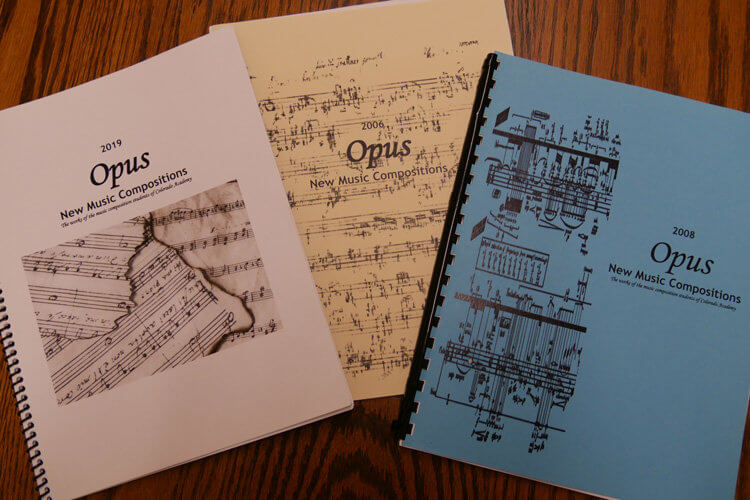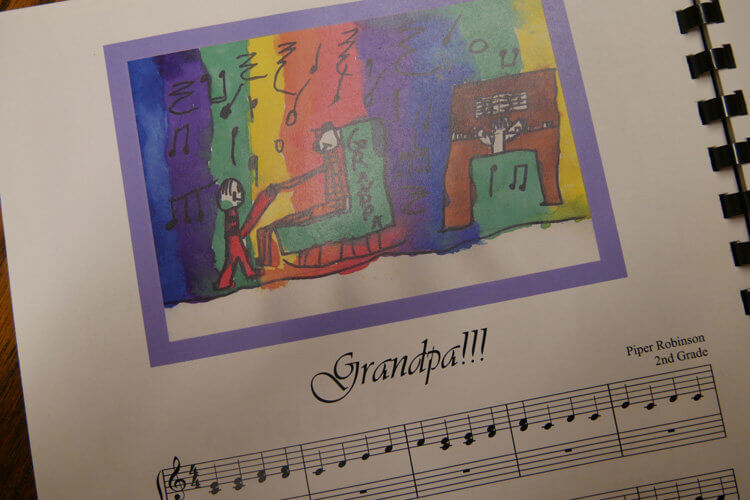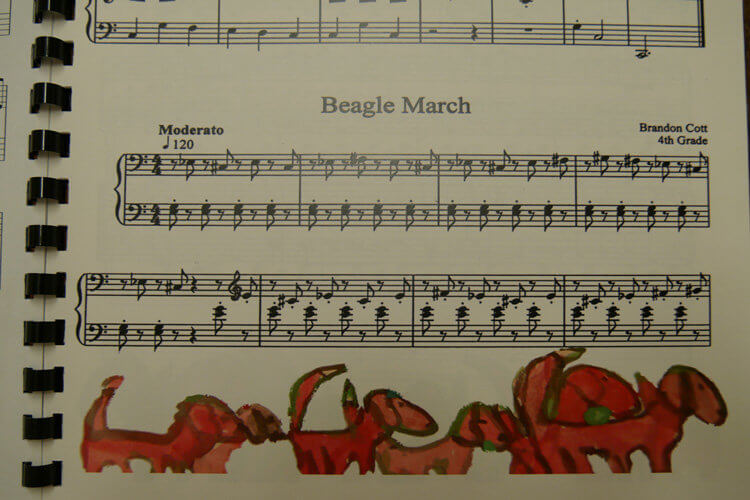Opus.
The first definition of this word is quite simple: work. More specifically, opus refers to a musical composition or set of compositions.

At Colorado Academy, the annual booklet, Opus: New Music Compositions, refers to the musical and artistic work of students. Opus will celebrate its fourteenth year in 2020—that’s 14 years showcasing the work of creative student composers illustrated by the equally creative work of student artists.
“I encourage the composers to pick interesting titles for their music, because works with interesting titles will more likely to be illustrated in the book,” Music Composition Teacher Brian Golden says. “Picking a title focuses students, and then sometimes, the title drives the music they compose.”

Glance back through the years of Opus and you will see some evocative titles that have been delightfully illustrated: “The Raindrops Walk,” “Smiley,” “Wedding Day,” “The Song that should not be Named,” “Caesar Salad,” “Rhythms of the Sea,” “The Detective,” “Beagle March,” “Brain Waves,” “Grandpa!!!” and on the list goes.
“It’s a challenge for artists to create a piece of work, visually interpreting what a title might mean,” says Visual Art Teacher Stashia Taylor. “There’s a lot of joy in these creations and some humor, because some of the titles are hilarious.”

‘When they have an instrument, they get it’
Golden says he has “always” written music, but not by using composer software. “I’m old school,” he confesses, smiling. “I like pencil in hand.” Before he launched the composition program at CA, he had taught improvisation classes with adults. Why not also teach children, he thought?
With two computers financed by the Parent Association encouraged by then-Director of Technology Jan Beattie, Golden launched his composition lab in 2005-2006. The first Opus in 2006 was illustrated by CA Second Grade students. The program quickly outgrew its home, and Golden persuaded CA to convert a large storage room in Schotters Music Center into a larger lab. “My goal was to fill the room with opportunities to compose,” Golden says. “My goal was fulfilled.”
The lab now has 10 digital audio workstations, which students can use with different notation software programs, including “Sibelius,” as well as several keyboards and synthesizers. In addition, Golden’s piano studio is packed with instruments students can use to experiment, including a theremin (the classic “spooky music” instrument), a chime tree, a bell tree, and drums.
“I rarely have a student who draws a blank when it comes to composing music,” Golden says. “When they have an instrument, they get it.”

‘These skills can carry over’
Golden offers composition lessons for students in Kindergarten through Grade 12 as part of CA’s Private Music Lesson Program. His philosophy is to encourage students to create music, document it (in Opus) and present it at the annual New Music Concert. He believes that, by composing their own music, students improve their understanding of how a composer’s mind works—how the composer communicates—and that enhances their understanding and appreciation of music.
“When they compose, students hear things, structure and bring patterns to music, and make decisions, which helps them organize their thoughts,” he says. “Those skills can carry over to any kind of activity that requires structure.”
Golden originated the idea of collaborating with art students to illustrate the compositions, and through the years, he has worked with several art teachers. Taylor offers the titles to students from Grade 4 through Upper School, some of whom jump at the chance to see their work published. “This is a small way that two different areas—music and art—interact,” Taylor says. “We can become a part of each other’s world.”
It’s all happening in a CA arts world, where compositions like “The Pixie and the Flower” and “In the Attic” can start in the imagination and come to life in performance and print.
